Japan
Japan to issue new 1,000-, 5,000-, and 10,000-yen notes (B368 - B370) in 2024
10 04, 2019 16:35 Category: Asia
On 9 April 2019, Japan’s Ministry of Finance announced plans to introduce a new series of notes in the first half of 2024. The new series will consists of three denominations (the existing 2,000-yen note is not being replaced) featuring bacteriologist Kitasato Shibasaburō on the 1,000-yen note; Tsuda Umeko, founder of Tsuda Juku University and the first Japanese woman to study in the US, on the 5,000-yen note; and industrialist Shibusawa Eiichi (who appears on Korea B201 - B206), on the 10,000-yen note. All three notes will feature 10-digit serial numbers, 3D holographic elements, elaborate watermarks, and larger number to aid the sight-impaired. Existing notes will continue to circulate in parallel for three to four years.


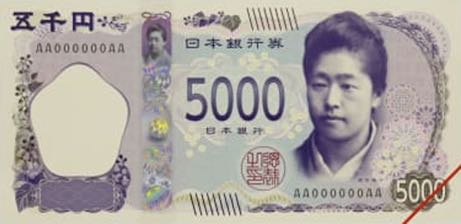
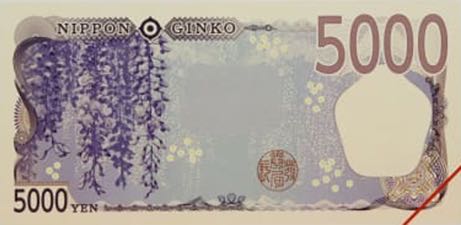
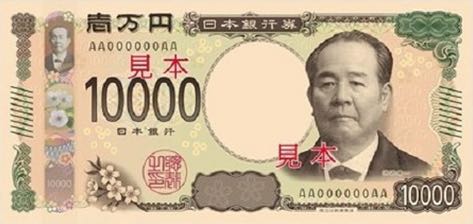
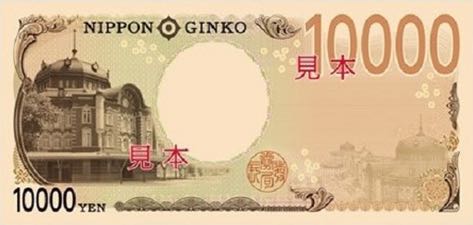
Courtesy of Mark Irwin, Kazutaka Nagura, Lexter Ibasco, 钞票百科 (Chaopiaobaike), and Ryutaro Arai.






Courtesy of Mark Irwin, Kazutaka Nagura, Lexter Ibasco, 钞票百科 (Chaopiaobaike), and Ryutaro Arai.
Japan new serial number color 1,000-yen note (B365c) confirmed introduced 18.03.2019
09 05, 2019 08:20 Category: Asia
According to a press release dated 10 May 2018, Japan’s Ministry of Finance changed the color of the serial numbers on 1,000-yen notes from brown (B365b) to blue (B365c) starting on 18 March 2019.
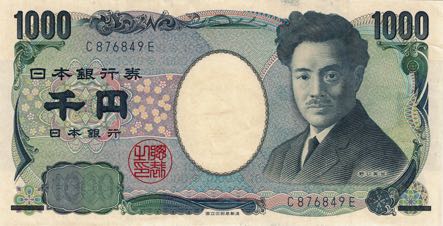
Courtesy of Kazutaka Nagura and Akina Wada (https://www.buntetsu.net/mbc/).

Courtesy of Kazutaka Nagura and Akina Wada (https://www.buntetsu.net/mbc/).
Japan chapter of The Banknote Book is now available
25 02, 2016 08:59 Category: The Banknote Book | East and Southeast Asia
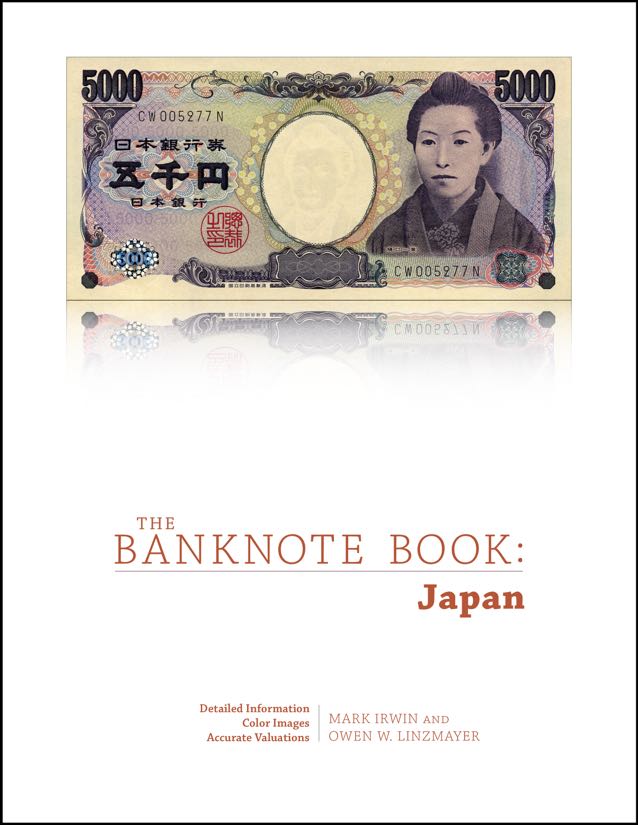
The Japan chapter of The Banknote Book is now available for individual sale and as a free download to subscribers.
This 48-page catalog covers notes issued by the Japanese Government from 1868 to 1948, the Great Japanese Imperial National Bank from 1873 to 1878, the Bank of Japan from 1885 to present, and the Allied Military from 1945 to 1957. Published 26 February 2016.
Each chapter of The Banknote Book includes detailed descriptions and background information, full-color images, and accurate valuations. The Banknote Book also features:
- Sharp color images of note’s front and back without overlap
- Face value or date of demonetization if no longer legal tender
- Specific identification of all vignette elements
- Security features described in full
- Printer imprint reproduced exactly as on note
- Each date/signature variety assigned an individual letter
- Variety checkboxes for tracking your collection and want list
- Date reproduced exactly as on note
- Precise date of introduction noted when known
- Replacement note information
- Signature tables, often with names and terms of service
- Background information for historical and cultural context
- Details magnified to distinguish between note varieties
- Bibliographic sources listed for further research
Subscribe to The Banknote Book
If you collect the entire world or a large number of countries, buying a subscription is the best deal because it's less expensive than buying chapters individually, and it entitles you to every chapter currently available as well as everything published—or revised (click here to see the Change Log)—during the term of your subscription.

Sign up for Email Notifications
If you would like to receive email notifications whenever a new chapter of The Banknote Book is published, please join the email list by clicking the button below.

Hong Kong residents demand cash for Japanese WWII military yen
14 08, 2015 11:31 Category: East and Southeast Asia
South Korea banknote printer seeking more overseas contracts
24 06, 2014 12:34 Category: Asia
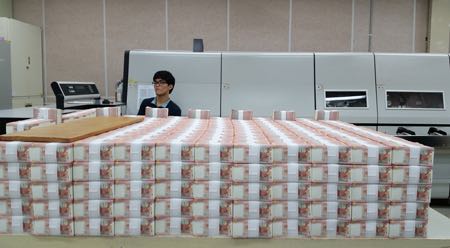
According to an article in Korea Times dated 24 June 2014, Korea Minting, Security Printing & ID Card Operating Corp. (KOMSCO) has seen its production volume halved over the past five years, and hopes to utilize excess capacity by obtaining contracts to print banknotes for other countries. Countries for which KOMSCO has produced or is producing "currencies" (may include coins, not just banknotes) include China, Indonesia, Israel, Japan, Libya, Peru, Switzerland, Thailand, and Vietnam. Last year KOMSCO won an order from Peru to produce 305 million 50-nuevo sole notes, with delivery to be completed by the end of June 2014.
Japan revised 5,000-yen note confirmed
03 07, 2014 18:59 Category: East and Southeast Asia
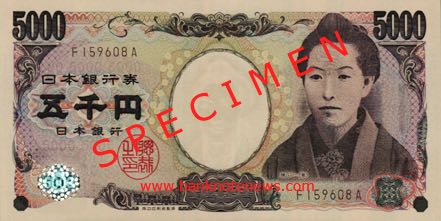

According to an article on JapanToday dated 8 May 2014, on 12 May the Bank of Japan introduced a new 5,000-yen note like the existing notes (P105), but with high-tech anti-forgery features and enhanced convenience for visually impaired people. This note has a 1- or 2-letter prefix, brown serial numbers, and different shaped seal over hologram at lower right front.
Courtesy of Mark Irwin.
Japan seeks to print notes for other countries
29 11, 2013 12:56 Category: East and Southeast Asia
According to an article on Bernama dated 29 November 2013, Japan's Ministry of Finance has launched a promotion campaign in the hope of attracting orders to print banknotes and passports for other countries by highlighting Japan's cutting-edge anti-counterfeit technologies. Japan's only experience printing notes for other countries was when it printed South Korean notes during the Korean War.
Japan color change of serial numbers on 1,000- and 10,000-yen notes confirmed
16 10, 2011 07:41 Category: East and Southeast Asia

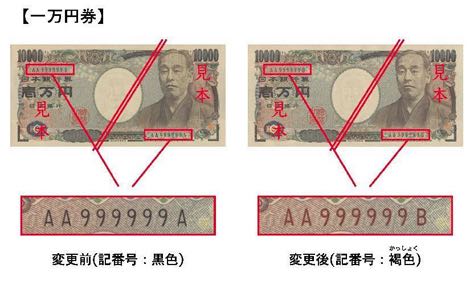
According to a press release dated 26 April 2011, the Bank of Japan is changing the color of the serial numbers on the 1,000 (US$12.25) and 10,000 (US$122) yen banknotes from black to brown on 19 July 2011. Other than this minor change, the notes will remain the same as the existing P104 and P106 designs which have been in circulation since 2004.
Courtesy of Kazutaka Nagura and Kinichiro Fujikawa.
Japan's 2,000-yen note popular in Okinawa
23 07, 2010 08:04 Category: East and Southeast Asia
The following story is from a post on Japan Update dated 22 July 2010:
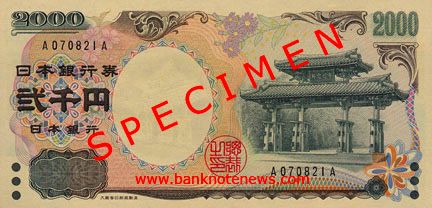
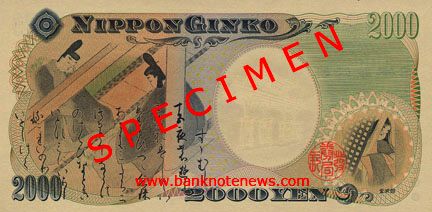
Okinawa still likes the unpopular 2000-yen note
The Japanese currency note is the only one in circulation bearing the number ‘2’, enough of a rarity to make people distrust it, leaving only Okinawans as champions of the beleaguered money.
The Bank of Japan began issuing the ¥2000 bill on July 19, 2000 to commemorate the Group of Eight summit in Okinawa, but this bill didn’t catch on with the general public and remains unpopular. There are around 110 million ¥2,000 notes in circulation, about 1% of all Japanese currency.
Okinawans have good reasons for loving the bill; the Okinawan symbol ’Shureimon’ is printed on one side of the bill. The Shureimon Gate in Naha was built in the 16th century as the main gate to Shuri Castle. Shureimon Gate is a symbol of peace, and Okinawans say they want “to promote the spirit of peace from Okinawa” with the ¥2,000 note. Local Okinawa businesses have begun a campaign to promote use of the currency, with local banks converting ATM machines to accept them and shopping malls now giving change in ¥2,000 notes.
The Bank of Japan stopped issuing the ¥2000 bill in fiscal year 2003, and has kept tons of the bills stored in its safe. The circulation of this bill peaked in 2004 but has been in decline ever since. There are various reasons to unpopularity of the ¥2000 bill. The bill resembles the ¥5000 note, and the lack of ATMs that issue them when customers draw cash have made citizens wary.
Courtesy of Mike Link.


Okinawa still likes the unpopular 2000-yen note
The Japanese currency note is the only one in circulation bearing the number ‘2’, enough of a rarity to make people distrust it, leaving only Okinawans as champions of the beleaguered money.
The Bank of Japan began issuing the ¥2000 bill on July 19, 2000 to commemorate the Group of Eight summit in Okinawa, but this bill didn’t catch on with the general public and remains unpopular. There are around 110 million ¥2,000 notes in circulation, about 1% of all Japanese currency.
Okinawans have good reasons for loving the bill; the Okinawan symbol ’Shureimon’ is printed on one side of the bill. The Shureimon Gate in Naha was built in the 16th century as the main gate to Shuri Castle. Shureimon Gate is a symbol of peace, and Okinawans say they want “to promote the spirit of peace from Okinawa” with the ¥2,000 note. Local Okinawa businesses have begun a campaign to promote use of the currency, with local banks converting ATM machines to accept them and shopping malls now giving change in ¥2,000 notes.
The Bank of Japan stopped issuing the ¥2000 bill in fiscal year 2003, and has kept tons of the bills stored in its safe. The circulation of this bill peaked in 2004 but has been in decline ever since. There are various reasons to unpopularity of the ¥2000 bill. The bill resembles the ¥5000 note, and the lack of ATMs that issue them when customers draw cash have made citizens wary.
Courtesy of Mike Link.

